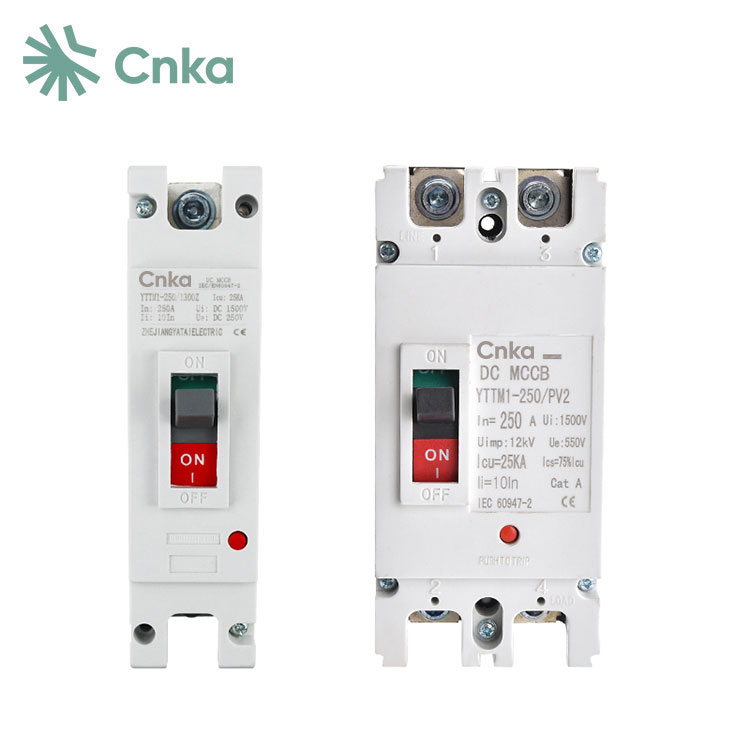What Makes DC Circuit Breakers Essential for Modern Electrical Systems?
2024-12-26
In today’s rapidly advancing world of electrical systems, protection is crucial for ensuring the safety and longevity of devices and circuits. One essential component that plays a vital role in protecting electrical circuits is the DC circuit breaker. But what exactly is a DC circuit breaker, and why is it so important in modern electrical applications?
In this blog, we’ll dive into the significance of DC circuit breakers, their functions, and how they are used in various industries.
1. What Is a DC Circuit Breaker?
A DC (Direct Current) circuit breaker is an electrical switch designed to protect electrical circuits from damage caused by overload or short circuits. It automatically interrupts the current flow when it detects an abnormal condition, such as excessive current or a fault, preventing further damage to the circuit or equipment.
Unlike AC (Alternating Current) circuits, which reverse direction periodically, DC circuits maintain a constant flow of current in one direction. As a result, the DC circuit breaker has to work differently compared to its AC counterpart, which makes it specialized for use in DC applications.
2. Why Are DC Circuit Breakers Important?
DC circuits are commonly used in various applications, including renewable energy systems like solar power, electric vehicles (EVs), battery storage systems, and telecommunications. Here’s why DC circuit breakers are essential:
- Protecting Sensitive Equipment: DC systems often involve sensitive and expensive equipment, such as solar inverters, electric vehicle charging stations, and battery storage units. If a fault occurs in the circuit, the DC circuit breaker ensures that the system is safely disconnected, preventing costly damage.
- Preventing Overload and Short Circuits: Overloads or short circuits can cause overheating, which can lead to fires, component failures, or even system-wide shutdowns. A DC circuit breaker automatically disconnects the power to the affected circuit, ensuring the protection of both the equipment and the users.
- Ensuring Safety in High Voltage Systems: DC systems often operate at higher voltages than typical AC systems, especially in large-scale installations like solar farms or electric vehicles. The DC circuit breaker is specifically designed to handle the challenges posed by these high-voltage systems, ensuring safety at all times.
3. How Do DC Circuit Breakers Work?
DC circuit breakers function by detecting overcurrent situations, such as excessive current flow, and automatically tripping to interrupt the circuit. Here's a basic breakdown of how they work:
- Current Detection: The DC circuit breaker uses sensors to continuously monitor the current flow in the circuit. When the current exceeds a preset limit, typically caused by a short circuit or overload, the breaker is triggered to disconnect the power.
- Arc Extinguishing: When the breaker opens the circuit to stop the current flow, an arc forms between the contacts. In DC circuits, the arc can persist due to the constant flow of current. DC circuit breakers are designed with advanced arc-extinguishing mechanisms to quickly and safely quench the arc, preventing further damage.
- Automatic Reset or Manual Reclosure: Some DC circuit breakers feature an automatic reset function, while others require manual resetting after they have tripped. The automatic reset ensures continuous protection without manual intervention, while the manual reset provides an added layer of security by ensuring that users check the system before restoring power.
4. Where Are DC Circuit Breakers Used?
DC circuit breakers are found in a wide range of applications, particularly where DC systems are prevalent. Some key areas of usage include:
- Solar Power Systems: Solar power installations use DC circuit breakers to protect the DC circuits between the solar panels and inverters. These breakers ensure the safety of the system in case of overloads or faults.
- Electric Vehicles (EVs): DC circuit breakers are used in EVs to protect the battery and power distribution systems. They help prevent damage to the electrical system in case of overcurrent or short circuits, ensuring the vehicle’s safety and functionality.
- Battery Storage Systems: Battery storage systems, used in homes and businesses for energy backup, require DC circuit breakers to protect the batteries and the associated power electronics from damage due to overload or faults.
- Telecommunications and Data Centers: DC power supplies are commonly used in telecommunications and data center operations to ensure uninterrupted service. DC circuit breakers are essential in protecting these critical systems from electrical faults.
- Industrial Equipment: DC circuit breakers are also used in various industrial equipment, such as electroplating machines, electric cranes, and other systems that operate on direct current.
5. What Are the Different Types of DC Circuit Breakers?
There are several types of DC circuit breakers designed to meet different application needs:
- Thermal Circuit Breakers: These circuit breakers use a bimetallic strip that heats up and bends when an overload occurs. Once the strip bends enough, it trips the breaker, disconnecting the circuit. Thermal breakers are typically used for low to medium current applications.
- Magnetic Circuit Breakers: These circuit breakers use a magnetic field to detect overload conditions. When the current flow exceeds the set limit, the magnetic force activates a trip mechanism, opening the circuit. These breakers are ideal for high current or instantaneous fault detection.
- Hydraulic-Magnetic Circuit Breakers: Combining the features of both thermal and magnetic breakers, these circuit breakers are designed to provide more precise and reliable protection. They are commonly used in industrial and commercial DC applications.
- Solid-State Circuit Breakers: Solid-state breakers use electronic components to detect faults and interrupt current flow. These breakers are ideal for high-performance systems and applications requiring fast response times, such as data centers or electric vehicles.
6. How to Choose the Right DC Circuit Breaker?
When selecting a DC circuit breaker, it’s essential to consider factors such as:
- Voltage Rating: Ensure the breaker’s voltage rating matches the operating voltage of the DC system.
- Current Rating: Choose a breaker with an appropriate current rating to protect the circuit from overloads.
- Breaking Capacity: This refers to the breaker’s ability to safely interrupt fault currents. The breaker should be able to handle the maximum short-circuit current that could occur in the system.
- Response Time: The breaker’s response time should be fast enough to disconnect the circuit before damage occurs. This is particularly important in high-power DC systems.
- Temperature Rating: Ensure that the breaker can withstand the operating temperature range of the system without malfunctioning.
Conclusion
DC circuit breakers are a vital component in protecting DC-powered systems from electrical faults, overloads, and short circuits. As industries such as renewable energy, electric vehicles, and telecommunications continue to grow, the role of DC circuit breakers will only become more significant. By selecting the right type of breaker and ensuring proper installation, you can safeguard your DC systems and ensure their longevity and efficiency.



